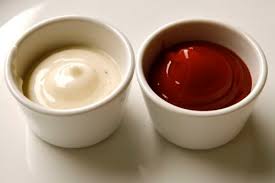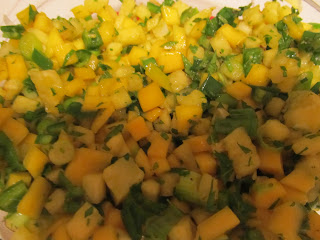"What is Tahini?" you may ask. The first time I made Hummus, I asked myself the same question. Tahini Paste is a common ingredient in a lot of middle-eastern foods as well as dips and sauces. It's sometimes called "Sesame Paste". I have run into a lot of recipes that call for it. One of the biggest problems is that at 16 oz. jar of decent Tahini of it can cost $12-15.
In the last couple of months, I've figured out that I can save this money. How did I figure this recipe out? Well, funny story. I was grumbling about how much it cost and I looked at the back of the jar to see what all was in it. It turns out there are TWO ingredients in this liquid gold I've buying. On top of that, they're incredibly common and incredibly cheap ingredients. So, now I've worked out an easy method and the right proportions, I'm sharing this recipe with you.
Ingredients:
2 c. Sesame Seeds
1/2 c. Unrefined Sesame Oil
Directions:
1. Put the 2 c. of Sesame Seeds in a blender. With the lid on the blender, blend on a medium-high setting (Mix or Purée) until the seeds are finely ground. You may have to scrape the sides with a rubber spatula once or twice and run the blender again.
2. With a rubber spatula, scrape the sides to get all the ground seeds to the bottom in a pile around the blade. Then, add the Sesame Oil. Blend on a low setting (Stir) for 30 - 60 seconds until the oil and seeds are well mixed. Then, blend on a medium-low setting (Chop or Mix) for at least two minutes. The seeds should continue to blend into finer pieces so that the whole thing gets to be a thick pasty consistency.
3. Scoop the paste out of the blender into a jar, and store in the refrigerator until ready to use.
Sunday, August 26, 2012
Sunday, August 19, 2012
Mango Pineapple Salsa
This week, I'm doing something a little different. We're all familiar with savory, tomato-based salsas. But, salsas can be quite varied. Unlike most which are vegetable-based (I know a tomato is a fruit), this one is fruit-based.
Ingredients:
1/2 fresh Pineapple
1 Mango
1/2 c. finely chopped fresh Mint Leaves
2 Jalapeños
*You can use 1, if you want it less spicy.
1 c. chopped Green Onion - white and green parts without the roots
1/2 t. Curry
1/4 t. Salt
Juice of 1 Lime
Directions:
1. Peel the 1/2 Pineapple and remove the eyes. Finely cube the pineapple into small pieces slightly smaller than 1/4". Then, peel and cube the Mango into pieces of the same size. Put the chopped pineapple and mango in a medium-sized mixing bowl.
2. Remove the jalapeño stems and deseed the peppers. Finely mince the jalapeños, and add them to the mixing bowl.
3. Add the onions and mint leaves. Stir the mix together.
4. Add the Curry, Salt and Lime Juice. Stir well.
5. Chill in the refrigerator for at least 2 hours. Stir before serving.
Ingredients:
1/2 fresh Pineapple
1 Mango
1/2 c. finely chopped fresh Mint Leaves
2 Jalapeños
*You can use 1, if you want it less spicy.
1 c. chopped Green Onion - white and green parts without the roots
1/2 t. Curry
1/4 t. Salt
Juice of 1 Lime
Directions:
1. Peel the 1/2 Pineapple and remove the eyes. Finely cube the pineapple into small pieces slightly smaller than 1/4". Then, peel and cube the Mango into pieces of the same size. Put the chopped pineapple and mango in a medium-sized mixing bowl.
2. Remove the jalapeño stems and deseed the peppers. Finely mince the jalapeños, and add them to the mixing bowl.
3. Add the onions and mint leaves. Stir the mix together.
4. Add the Curry, Salt and Lime Juice. Stir well.
5. Chill in the refrigerator for at least 2 hours. Stir before serving.
Sunday, August 12, 2012
Caraotas Negras
Probably the standard for Latin - especially Caribbean cooking - is Black Beans. This is one of those dishes I learned while living in Venezuela. The word for the type of bean that is a Black Bean in Venezuelan Spanish is "Caraota". In Puerto Rico and the Dominican Rebublic, it's called "Habichuela". But, please don't call them "Frijoles" unless you're in Cuba or Mexico. Elsewhere, a frijol refers to a white bean.
This is a pretty simple dish to make, and incredibly versatile too. The recipe is basically the same as my Basic Beans post, but with a little extra going on.
Ingredients:
2 c. Dried Black Beans
10 c. Water
1 t. Salt for boiling the beans
1 T. Olive Oil for boiling
1/4 c. Olive Oil for sautéeing.
1 sm. Yellow Onion
1 large Bell Pepper
1 or 2 Chile Peppers (Optional)
3 or 4 cloves of Garlic
Salt and Pepper to taste
Directions:
1. Soak the beans in the 10 c. of water over night. You may put in a pinch of Fennel Seed and a pinch of Baking Soda while soaking them. It might be helpful to review my post on how to make beans before doing this part.
2. Add the 1 t. of Salt and the 1 T. of Olive Oil to the soaking beans. Then, cook the beans on high, and boil them for 1 - 1 1/2 hours, or however long it takes to soften them. As it's boiling, you will probably need to scoop the gray foam off the top before it boils over.
3. As the beans are boiling, mince the onions and garlic finely and set them aside. I have found you can do this in a food processor on Pulse. Do not turn the food processor on full or it will liquefy the onions.
4. Quarter the Bell Pepper and remove the seeds and stem. There's a helpful hint on chopping peppers in my post on Hummus.
If you are using the chile peppers, cut the tops off, cut them in half and de-seed them. Next, finely mince the peppers. Again you can use a food processor on Pulse, but be especially careful with peppers as they will liquefy very easily. Set the minced pepper aside.
5. Heat the 1/4 c. of Olive Oil in a large skillet over medium heat. Add in the minced Onion and Garlic. Let them sauté until they begin to brown a little. Then, add the peppers and continue to sauté them, stirring occasionally. Cover the onion/pepper mixture with a lid while it cooks, continuing to stir occasionally. Cook the mixture until all the ingredients are soft. This is called the "alineamiento" (I don't know an English word for this).
6. When the beans are soft, add the alineamiento to them and simmer together for apx. 1/2 hour. They should thicken a bit. You can cook them to desired thickness. Add salt and pepper to taste before serving.
*There are various ways to serve Caraotas Negras:
1. You can eat them as they are, like a soup. This is commonly called "Turtle Soup."
 Despite what your favorite cartoon about ninja turtles taught you, Turtle Soup does not contain turtle meat. It's called that because black beans are sometimes called "turtle beans".
Despite what your favorite cartoon about ninja turtles taught you, Turtle Soup does not contain turtle meat. It's called that because black beans are sometimes called "turtle beans".
2. You can serve them over rice.
3. A very typical thing done in the Caribbean is to serve caraotas negras over spaghetti noodles, and then add a Tablespoon of Mayonnaise and Ketchup. You then, stir the mayo and ketchup into the beans before eating.

Don't judge it until you try it!!!
This is a pretty simple dish to make, and incredibly versatile too. The recipe is basically the same as my Basic Beans post, but with a little extra going on.
Ingredients:
2 c. Dried Black Beans
10 c. Water
1 t. Salt for boiling the beans
1 T. Olive Oil for boiling
1/4 c. Olive Oil for sautéeing.
1 sm. Yellow Onion
1 large Bell Pepper
1 or 2 Chile Peppers (Optional)
3 or 4 cloves of Garlic
Salt and Pepper to taste
Directions:
1. Soak the beans in the 10 c. of water over night. You may put in a pinch of Fennel Seed and a pinch of Baking Soda while soaking them. It might be helpful to review my post on how to make beans before doing this part.
2. Add the 1 t. of Salt and the 1 T. of Olive Oil to the soaking beans. Then, cook the beans on high, and boil them for 1 - 1 1/2 hours, or however long it takes to soften them. As it's boiling, you will probably need to scoop the gray foam off the top before it boils over.
3. As the beans are boiling, mince the onions and garlic finely and set them aside. I have found you can do this in a food processor on Pulse. Do not turn the food processor on full or it will liquefy the onions.
4. Quarter the Bell Pepper and remove the seeds and stem. There's a helpful hint on chopping peppers in my post on Hummus.
If you are using the chile peppers, cut the tops off, cut them in half and de-seed them. Next, finely mince the peppers. Again you can use a food processor on Pulse, but be especially careful with peppers as they will liquefy very easily. Set the minced pepper aside.
5. Heat the 1/4 c. of Olive Oil in a large skillet over medium heat. Add in the minced Onion and Garlic. Let them sauté until they begin to brown a little. Then, add the peppers and continue to sauté them, stirring occasionally. Cover the onion/pepper mixture with a lid while it cooks, continuing to stir occasionally. Cook the mixture until all the ingredients are soft. This is called the "alineamiento" (I don't know an English word for this).
6. When the beans are soft, add the alineamiento to them and simmer together for apx. 1/2 hour. They should thicken a bit. You can cook them to desired thickness. Add salt and pepper to taste before serving.
*There are various ways to serve Caraotas Negras:
1. You can eat them as they are, like a soup. This is commonly called "Turtle Soup."
2. You can serve them over rice.
 |
| Like this. |
3. A very typical thing done in the Caribbean is to serve caraotas negras over spaghetti noodles, and then add a Tablespoon of Mayonnaise and Ketchup. You then, stir the mayo and ketchup into the beans before eating.
Don't judge it until you try it!!!
Sunday, August 5, 2012
Kristen's Cranana Bread
Before we begin baking this delicious bread, a couple of thanks are in order. First, thank you to my lovely husband who allows me to guest-post on his blog. Second, to The Baking Bird, the creator of the recipe on which this recipe is based; I have modified it a bit over time by adding craisins and walnuts, as well as experimenting with the ingredients in accordance with my preferred flavoring and consistency desires.
So, here it is. Cranana bread in 10 easy steps.
3 overly ripe bananas. The grosser, the better.
1/3 cup applesauce
1/4 cup oil
1/2 cup raw sugar
2 tbsp molasses
1 1/2 cups all purpose flour
1/2 cup whole wheat flour
3/4 tsp. baking soda
1 tsp cinnamon
1/4 tsp nutmeg
1/4 tsp allspice (This is its own thing, not just a mixture of spices. Not that I ever thought that.)
1/2 tsp salt
1/4 c craisins
Some walnuts
Step 1: Go bananas!
Usually I freeze the bananas in their peels in order to ripen them more quickly and to keep any household pests out of them as they do so. The day I make the banana bread, I take them out and allow them to thaw so I can peel them. Running hot water over them can help. Don't worry, these bananas really can't get much slimier, so water won't hurt.
Step 2: Smmmmoooosh the bananas!
This is the fun part.
I like to leave them a little chunky.
Step 3: Make sure to give each ingredient their close-up.
Some people say they can't bake.
I say some people can't pay attention to their ingredients.
Step 4: Mix the wet ingredients
Step 5: Sift the dry ingredients together and stir them slowly into the wet mixture.
Step 6: Check the consistency
I love whole wheat flour, but sometimes it can make baked goods too thick and dry. The batter should be thicker than cake batter but more runny than a dough intended to roll into a ball (like pizza dough). If the batter is too thick, I find adding a tablespoon of water thins it without changing the flavor. If it is too thin, add (slowly) more flour. If the batter seems way too thick or way too thin, double-check your recipe and make sure you didn't miss Step 3. Think real hard.
Step 7: Stir in cranberries and walnuts to taste.
Cranberries add a nice texture and complimentary flavor to the bananas. Be careful, though! They are very tart and too many cranberries can overpower the bread. Don't be afraid to dip your finger in and take a taste when no one's looking. Here's how Matthew and my conversation went:
Matthew: You know, the good thing about vegan baking is that you can eat as much batter as you want and not care about the raw eggs making you sick. *Licks the now emptied bowl*
Me: As opposed to normal baking...where I eat as much batter as I want and don't care about the raw eggs making me sick.
After years of eating raw cookie dough and licking cake battered whisks, I'm still alive. Just sayin'.
Step 8: Fill a lightly greased bread pan approximately 3/4 full and bake for 45-60 minutes at 375 degrees.
Depending on your oven and the size of your bread pan, the length of time to cook may vary. Just use the clean fork test. Going by the "golden brown edges" test doesn't work when the bread is already golden brown.
Step 9: Make more puns.
Voila! The Grand Crananyon!
Step 10: Enjoy!
Labels:
Bread,
Breakfast Foods,
Side Dishes,
Vegan,
Vegetarian
Subscribe to:
Posts (Atom)
























